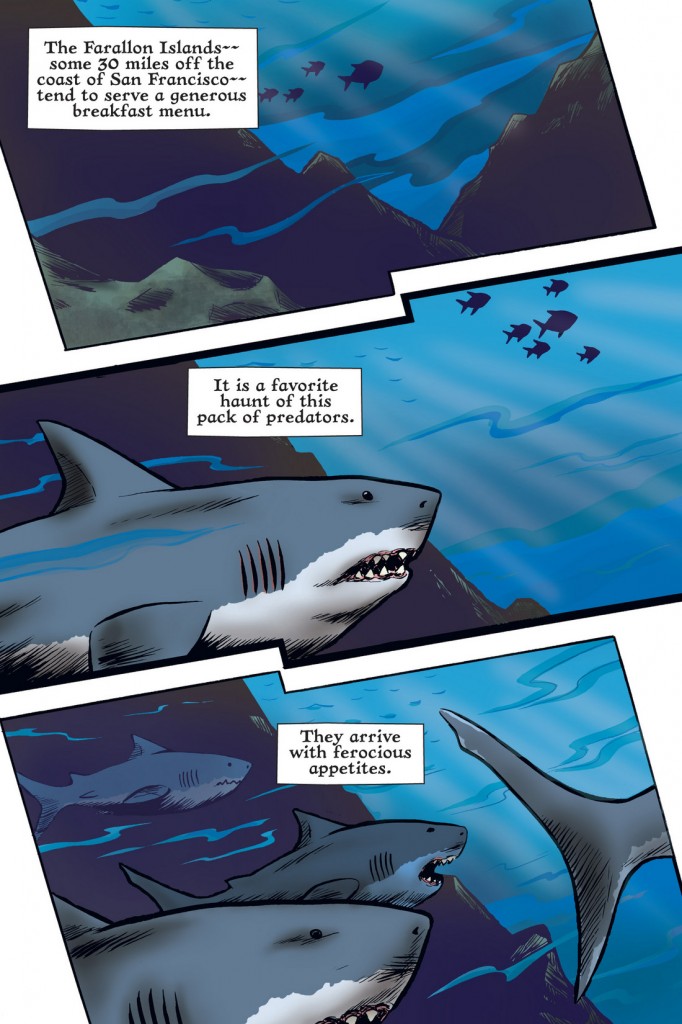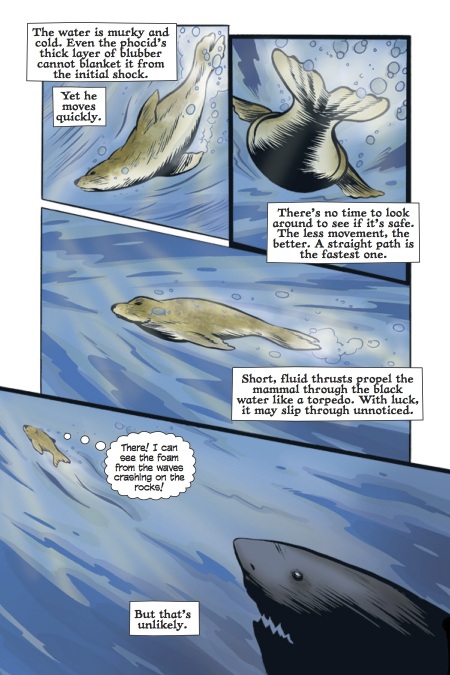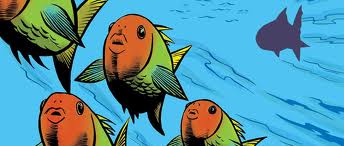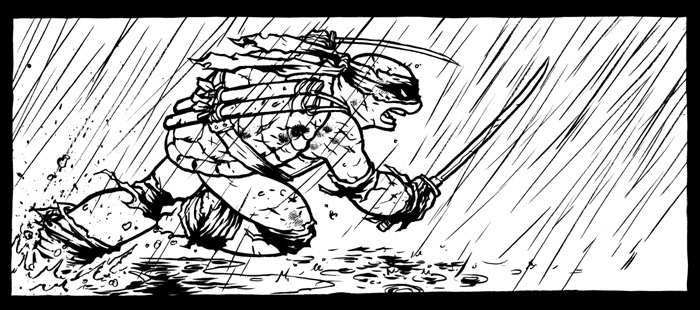Hey ComicAttackers! Today we sit down with cool creator Matt Dembicki, whose great graphic novel, Xoc: The Journey of a Great White, was released recently by Oni Press. Matt took some time to let us pick his brain!
—————————–
 ComicAttack: Thanks for joining us today, Matt. First off, big congrats on Xoc! I think this is a fantastic graphic novel (our review here). Now that this has been released, both in stores and digitally, how do you feel?
ComicAttack: Thanks for joining us today, Matt. First off, big congrats on Xoc! I think this is a fantastic graphic novel (our review here). Now that this has been released, both in stores and digitally, how do you feel?
Matt Dembicki: It feels great! I’ve been working on the book for a while, since 2009. To see it in color, especially in a hard cover, is very gratifying!
CA: Throughout Xoc, as well as in your author’s notes at the end, I think you make it pretty clear why you made this, but for our readers who haven’t had a chance to pick it up, why’d you create this story?
MD: I love sharks. Ever since I saw the movie Jaws as a kid, I’ve been fascinated by them, especially great whites. But as fearsome as they are, they are susceptible to humans. This book started as a small side project, but as I got into the research—I’m a journalist by profession, so I tend to dig—I was come across things I had never heard of, such as the Pacific garbage patch and the dumping of ammunition and low-level radioactive waste off the coast of California after WWII. And even though I knew about shark-fin soup—and how the fins were obtained—I didn’t know the scope or cruelty of the practice. It’s been surprising how polarizing the book has been so far. Some folks just don’t want to hear it and debunk the facts as coming from an overzealous environmentalist. I don’t consider myself an environmentalist but rather a pragmatist. I’m not opposed to fishing, even for sharks, but I am opposed to wasting the entire shark just to get the fins. If we keep up some of these patterns of pollution and waste, at some point it’s going to have draconian effects on the human race. Having balance in nature is in our best interest of self preservation.
CA: In the book there are seals, sea turtles, and a ton more ocean life. Certainly the oceans are teeming with a variety of animals that could also be main characters, but you chose Xoc. Aside from the old British comic Hook Jaw, there aren’t really any shark-centric books out there. So why a shark over all these other types of creatures for the lead?
 MD: It goes back to that fascination/fear thing with sharks, especially great whites. We generally view them as villains, yet we have a soft spot for them and cheer for them when they face adversity. It’s what makes Shark Week on television so popular. I also find it a lot of fun to draw gapping jaws with rows of jagged teeth!
MD: It goes back to that fascination/fear thing with sharks, especially great whites. We generally view them as villains, yet we have a soft spot for them and cheer for them when they face adversity. It’s what makes Shark Week on television so popular. I also find it a lot of fun to draw gapping jaws with rows of jagged teeth!
CA: Xoc started out as a black and white mini-comic, but now it’s a full color graphic novel. How did that process evolve from where it started to where it finished? Were there difficulties switching between the two formats to tell the same tale?
MD: I thought it was pretty seamless. In fact, I liked doing the story initially as mini-comics because it forced me to develop a certain pace in 20 pages and to finish the comics with somewhat of a cliffhanger. I wasn’t sure how that would convey into a graphic novel, whether those transitions would be too stiff. But for the most part it worked out well. I definitely plan to use the same approach with future books. The coloring was a bit of a challenge. For the black and white minis, I used a lot of black for the deep-ocean scene. But colorist Evan Keeling did a great job of tackling those issue while preserving the mood I was going for.
CA: Your art on this rocks. It has this slight Franco-Belgian feel to it, but with American layouts, which gives it a cool vibe. Have other comics you grew up on and read influenced your art or writing style?
MD: Thanks, Drew. I appreciate that. Stephen Bissette’s and Alan Moore’s run on Swamp Thing was a major influence on me. I loved the pacing, the stories, the art—it was brilliant. I’m also a fan of the Len Wein and Bernie Wrightson earlier work on Swamp Thing. I guess it must be something about the character. In fact, I kind of picture Xoc “speaking” in the same tone as Swamp Thing. For layouts, I always look to Gene Colan, especially his work on Tomb of Dracula. That really opened my eyes to layout and perspective.
CA: You’ve worked on projects like Trickster: Native American Tales and now Xoc, instead of the “traditional” superhero books, which still dominate a chunk of the North American market. Why do these projects over mask and cape stories?
 MD: It’s just personal interest. I tend to enjoy developing into research for a story, whether it’s historical, cultural or environmental. Nearly all the comics I read now are from indie publishers or self-published. When I was in high school, I read nearly all superhero comics. In college I lost interest in comics, and it wasn’t until I met my wife some 15 years later that I got back into it. She was reading Neil Gaiman’s Sandman at the time, and it prompted me to look at some of the comics I used to read. So I took out the Swamp Thing books and got back into it. Next thing I know I’m going to the Small Press Expo in Bethesda, Md., and I’m seeing comics in a whole new light.
MD: It’s just personal interest. I tend to enjoy developing into research for a story, whether it’s historical, cultural or environmental. Nearly all the comics I read now are from indie publishers or self-published. When I was in high school, I read nearly all superhero comics. In college I lost interest in comics, and it wasn’t until I met my wife some 15 years later that I got back into it. She was reading Neil Gaiman’s Sandman at the time, and it prompted me to look at some of the comics I used to read. So I took out the Swamp Thing books and got back into it. Next thing I know I’m going to the Small Press Expo in Bethesda, Md., and I’m seeing comics in a whole new light.
CA: In the same vein if you were given an open door to tackle any superhero, would you, and which hero would you choose?
MD: The two characters I would enjoy working on would be Swamp Thing and Aquaman. Pretty obvious, eh?
CA: The same day it came out in stores, Xoc went digital as well. How do you feel about digital versus print comics and the way the future of comic reading is heading?
MD: I’m not sure how I feel about it. I really enjoy holding a book in my hand, rolling the paper between my fingers and just smelling the paper. You can flip back and forth quickly and take in a whole page without toggling up and down the page. Digital comics still have some issues to hurdle. I guess I still fall on the print side of things, but I’m not a purist or hate digital or anything like that. I’m game for digital if it can reproduce the same scope I feel when reading a print comic.
CA: Finally, now that this is out, what’s next in the pipeline for you that we can look forward to reading? Final thoughts for our readers?
MD: In the short term, the anthology District Comics: An Unconventional History of Washington, D.C. (Fulcrum Publishing) comes out in early August. I edited the book, wrote two stories and illustrated one of them. In September, Sky Pony Press is publishing in color a graphic novel I did with my wife a few years ago called Mr. Big: A Tale of Pond Life. It’s also a nature-based story, with a snapping turtle as the main character. I also just edited the fifth issue of Magic Bullet, which is a free comics newspaper published by the D.C. Conspiracy, a comics creators collaborative in Washington, D.C. Regarding other projects down the pike, I’ve got a couple of historically based books lined up to come from Fulcrum, probably in 2014.
I’ll be tabling at Baltimore Comic Con and the Small Press Expo, both in September, and I’d love to chat with folks if they swing by.
CA: Awesome, thanks again for joining us, Matt!
——————————
Once again, Xoc: The Journey of a Great White is out now from Oni press, check it out! Also check out my column, From Friendly Ghosts To Gamma Rays, every Friday here at ComicAttack.net, where we look at all-ages comics goodness!
Drew McCabe
drew@comicattack.net



Great interview guys! Will be looking for this one at the LCS now!
Pingback: Comics A.M. | Kodansha’s Attack on Titan tops 9 million in Japan | Robot 6 @ Comic Book Resources – Covering Comic Book News and Entertainment